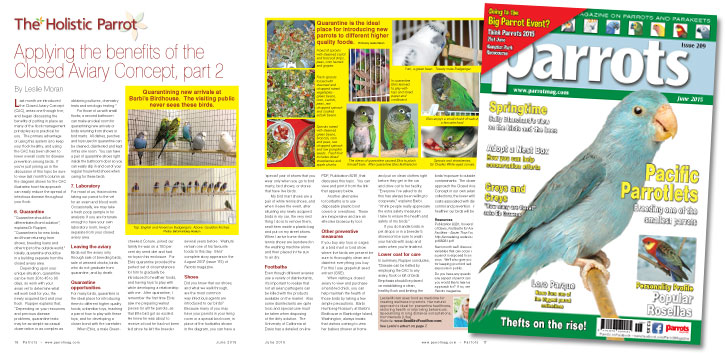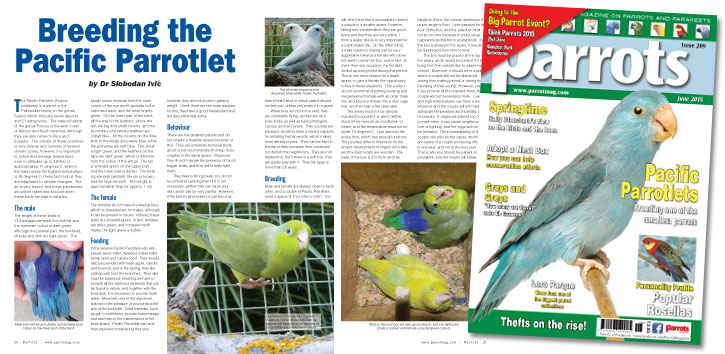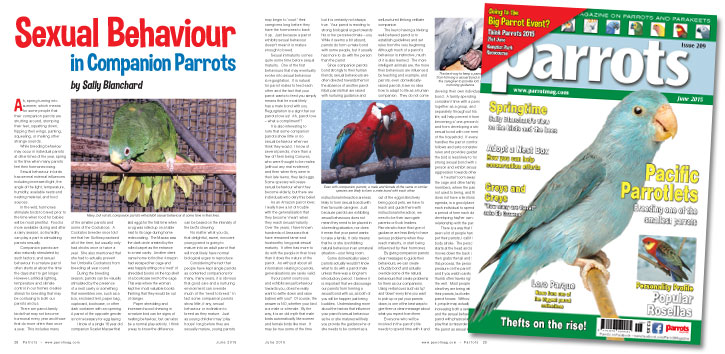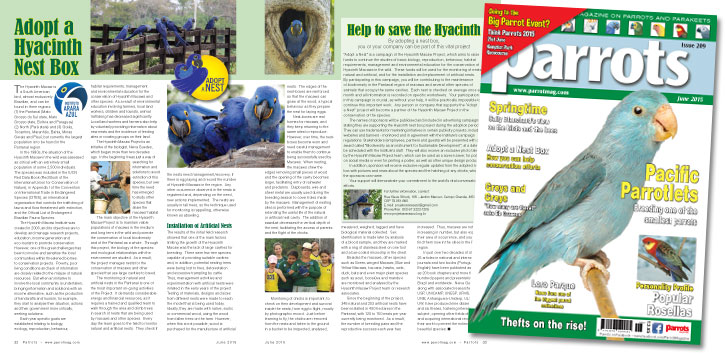
Applying the benefits of the Closed Aviary Concept, part 2
by Leslie Moran
Last month we introduced the Closed Aviary Concept (CAC), areas one through five, and began discussing the benefits of putting in place as many of the flock management principles as is practical for you. The primary advantage of using this system is to keep your flock healthy, and using the CAC has been shown to lower overall costs for disease prevention among birds. If you’re just joining us in the discussion of this topic be sure to view last month’s column as the diagram shown for the CAC illustrates how this approach can easily reduce the spread of infectious disease throughout your flock.
Buy Now!

by Dr Slobodan Ivic
The Pacific Parrotlet (Forpus coelestis) is a parrot in the Psittacidae family, in the genus Forpus which includes seven species and 21 subspecies. The natural habitat of the genus Forpus is the west coast of Mexico and South America, although they are also native to Peru and Ecuador. The climate of these countries is very diverse and consists of several climate zones, however, it is important to notice that average temperature, even in altitudes up to 3300m, is approximately 11 degrees C, while in the lower areas the highest temperature is 38 degrees C, these facts tell us they are adaptable to climate changes. The air is very humid, and these parameters should be taken into account when these birds are kept in aviaries.
The male: The length of these birds is 12.5cm (approximately five inches) and the dominant colour is dark green, although the parietal part, the forehead, cheeks and chin are light green. The bluish colour extends from the outer corner of the eye and it spreads to the nape and back, and the neck is grey-green. On the lower part of the back, all the way to the feathers, above the tail, are big and small coverts, and the secondary and tertiary feathers are cobalt blue.
Buy Now!

by Sally Blanchard
Ah, spring turning into summer, which means for some people that their companion parrots are strutting around, stomping their feet, squatting down, flipping their wings, panting, squealing, or making other strange sounds.
While breeding behaviour may occur in individual parrots at other times of the year, spring is the time when many parrots feel their hormones rising.
Sexual behaviour in birds has several external influences including increased light, the angle of the light, temperature, humidity, available nests and nesting material, and food sources.
In the wild, hormones stimulate birds to breed prior to the time when food for babies will be most plentiful. Food is more available during and after a rainy season, so humidity can play a part in stimulating parrots sexually.
Buy Now!

The Hyacinth Macaw is a South American bird, almost exclusively Brazilian, and can be found in three regions (1) the Pantanal (Mato Grosso do Sul state, Mato Grosso state, Bolivia and Paraguay) (2) North (Pará state) and (3) Goiás, Tocantins, Maranhão, Bahia, Minas Gerais and Piauí, but currently the largest population is to be found in the Pantanal region.
In the 1980s, the situation of the Hyacinth Macaw in the wild was assessed as critical with an extremely small population of some 2,500 individuals. The species was included in the IUCN Red Data Book (Red Book of the International Union for Conservation of Nature), in Appendix I of the Convention on International Trade in Endangered Species (CITES), an international organisation that controls the trafficking of fauna and flora threatened with extinction, and the Official List of Endangered Brazilian Fauna Species.
Buy Now!




